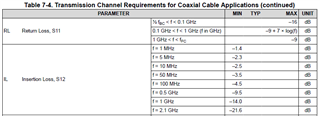Other Parts Discussed in Thread: TDES954, , TSER953
We are planning a surround view system based on TSER953 serializers in camera board and TDES960 and TDES954 in processor board for up to six cameras through two MIPI CSI-2 ports. The customer needs to have 30-40m cable lengths, which their current analog HD system is using. Currently, the cameras are 720p (1280x720), but the plan is to use full HD (1920x1080) in future. Ideally, the frame rate should be 60 Hz, but I guess 30Hz would be perfectly acceptable.
Without taking blanking or MIPI overhead into account, 30 fps 720p is roughly 700 Mbps and full HD about 1.5 Gbps (24 bpp). I'm a bit confused about TDES960 datasheet table 7-4:
Normally insertion loss is defined as positive number. What does the minimum insertion loss mean in this case? If we would use a low-loss coaxial cable with 10 dB/100ft attenuation @1GHz for full-HD, how can we calculate the approximate maximum cable length?

